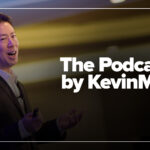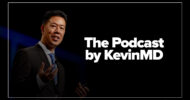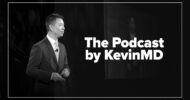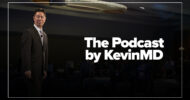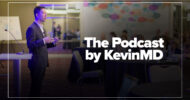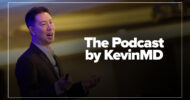Subscribe to The Podcast by KevinMD. Watch on YouTube. Catch up on old episodes!
Health care executive Kimberly Smith discusses her article “Why clinicians must lead health care tech innovation.” Kimberly explains why clinicians, who are on the front lines of patient care, are in the unique position to solve health care’s most complex challenges. As a registered wound care nurse, Kimberly has seen how technology like AI and advanced EHRs can both help and hinder clinical workflows. She argues that for health care tech to be effective, it must be developed with clinicians, not just for them, to ensure new tools ease administrative burdens and enhance patient care. This conversation explores how to bridge the gap between tech developers and frontline staff, ensuring the next wave of health care innovation is built from a clinical lens first. Learn why the future of health tech depends on the invaluable insight of clinical innovators.
Our presenting sponsor is Microsoft Dragon Copilot.
Want to streamline your clinical documentation and take advantage of customizations that put you in control? What about the ability to surface information right at the point of care or automate tasks with just a click? Now, you can.
Microsoft Dragon Copilot, your AI assistant for clinical workflow, is transforming how clinicians work. Offering an extensible AI workspace and a single, integrated platform, Dragon Copilot can help you unlock new levels of efficiency. Plus, it’s backed by a proven track record and decades of clinical expertise, and it’s part of Microsoft Cloud for Healthcare, built on a foundation of trust.
Ease your administrative burdens and stay focused on what matters most with Dragon Copilot, your AI assistant for clinical workflow.
VISIT SPONSOR → https://aka.ms/kevinmd
SUBSCRIBE TO THE PODCAST → https://www.kevinmd.com/podcast
RECOMMENDED BY KEVINMD → https://www.kevinmd.com/recommended
Transcript
Kevin Pho: Hi, and welcome to the show. Subscribe at KevinMD.com/podcast. Today we welcome Kimberly Smith. She’s a wound care nurse and health care executive. Today’s KevinMD article is “Why clinicians must lead health care tech innovation.” Kimberly, welcome to the show.
Kimberly Smith: Thank you. Thank you for having me.
Kevin Pho: All right, let’s start by briefly sharing your story. Then we’ll jump right into your KevinMD article.
Kimberly Smith: OK, great. My background is primarily in home health care. I spent most of that time as a wound and ostomy nurse, which is what I like to call the Navy Seals of nursing. It’s extremely hands-on, unpredictable, and definitely not for the faint of heart.
I started there, got my hands in patient care and learning all about them, and found out that if we didn’t have something, if it didn’t exist, we created it. There were lots of opportunities where we could be innovative and make some changes in how we deliver patient care.
Kevin Pho: Now tell me how you made that transition from being on the ground, so to speak, into an executive role.
Kimberly Smith: It was a long journey. I started seeing patients and then quickly moved into a corporate role so I could make a larger impact. I ran a multi-state program where we had multiple wound care nurses in the field doing wound care.
I was able to start using some virtual technology at that point to do online consultation, which was new back in 2013; that wasn’t heard of. I think I had the unique opportunity to build that program from the roots up. From there I headed into med device, where I learned a lot about product development, client education, and teaching patients and clinicians on how to use those devices.
I’ve moved into Net Health into my current role, which is a clinical executive where I help shape the products and make sure that that clinical voice is interpreted to our engineering team. That’s a neat journey and has led me to lots of opportunities.
Kevin Pho: Let’s talk about your KevinMD article, “Why clinicians must lead health care tech innovation.” For those who didn’t get a chance to read your article, tell us what it’s about.
Kimberly Smith: This article centers on one idea: that clinicians should be at the forefront of innovation. We shouldn’t be developing technology just for innovation’s sake. It should fit some of the problems and answer some of the challenges that we have in the field.
This came from sitting in meetings where a lot of new technology was introduced to us by leadership. These tools were designed with the best of intention. They looked great on the surface, but when you use them in the field, it just created more work.
What I wanted to say with this article is that we have these tools and they’re being built for clinicians, but not with them, and we’re missing the mark. That’s a recipe for disaster if you don’t have a clinical voice when you’re building clinician tools. I wanted to challenge that mindset and remind people that clinicians don’t just use these tools; we live with them patient by patient, hour by hour. We’re the ones who are using them.
Imagine this: You’re in a patient’s home. You need to take a photo of a wound for documentation. In a hospital setting, that’s easy. You just snap the photo. But in the home, there’s no lighting, no one to help you turn the patient. There’s a cat crawling across the bed, and now your photography app requires Wi-Fi that you don’t have. It’s so incredibly frustrating.
My purpose for this article was to show how the clinician’s voice is essential in shaping the future of health technology. If we’re not involved early, these tools drift away from reality and they’re not useful. Developers can often miss things like interoperability, regulatory compliance, or even the basic connectivity issues that we face in the field. I think that is so important that we keep the patients in mind, that we keep the clinicians in mind, and drive our innovation having their voice first and foremost.
Kevin Pho: You mentioned that sometimes if these tech tools aren’t clinician-led, it could lead to more work for the clinicians. What would be some examples of technology like that that creates more work because they don’t have a clinician spearheading the development?
Kimberly Smith: Sure. Let’s take an EMR, for example. An EMR is developed, and we always have these regulatory issues, the compliance issues, and they’re ever-changing. The regulatory and compliance issues are important. They are certainly important because that helps us deliver the ideal patient care and get the ideal patient outcomes, but we have to know how to capture the good work that we’re doing out there.
Sometimes that’s a big challenge. EMRs are developed to hopefully capture all of those things together, but they have to be streamlined; they have to be efficient. Don’t hand me a tool and tell me that it’s going to save time when it’s more work. It has to be less work. But if you give me that tool and it does save time and it gives me time back with my patients, that’s incredibly important to clinicians.
Kevin Pho: Now when you say that you have input in spearheading the device that your company makes, tell us what goes on behind the scenes. How do the engineers incorporate your feedback to them?
Kimberly Smith: There are so many things. First and foremost, I think the most important thing is being face-to-face with clinicians, being out in the field and spending time with them to see how it’s being utilized, to see the things that we’re not seeing in a test environment, that we don’t see the hiccups, we don’t see this alert coming.
Spending that time with clinicians and understanding what this technology means to them day-to-day is the first and foremost. We also have advisory panels where we have clinicians who come in, sit with us, tell us about the real-world uses, and make suggestions. Just being open to that feedback, welcoming that feedback, and soliciting that feedback from our clinicians is very, very important.
We also have conferences. We bring these clinicians into one space to collaborate and network. I think that is huge too, because when you’re talking with other clinicians in the same environment, you are seeing them face-to-face, and that starts ideas. We gather all those ideas in one place and then are able to translate that into our product. What makes sense for our product? Does it make sense for one clinician, or does it make sense for the whole? We have to weed through some of that as well. But understanding that clinical voice and understanding what it’s like day-to-day is the most important part in developing technology with the clinician in mind.
Kevin Pho: Now would you say that that scenario is the norm among health IT companies? Speaking in general, do the majority of them incorporate clinician input when developing their products?
Kimberly Smith: I would like to say yes, that should be the norm. Is it? I think it depends on the size of the company, how long the company has been around, and who’s leading. I definitely think there’s a lot of opportunity for growth in that area, and that’s what is sparking this article, too. Not only from the clinician side: “You need to stand up and have a voice.” Also to the companies who develop these products: “Don’t forget that this is the most important thing.” It is to have that clinician voice, put these processes in place to elicit that feedback so that you’re developing what is needed out there, not just for development’s sake.
Kevin Pho: You write in your article that health systems evaluate tech based on cost and ROI, return on investment. How can clinical leaders make a stronger case that ease of use for the care team should factor into that return on investment?
Kimberly Smith: One gap I see that happens over and over, and it’s not just in health tech, it’s in med device or any product that the hospital system brings on, is that a lot of times, the process is that folks who are not seeing the patient at the bedside are making these decisions. Some of that is logistical, and I know it makes sense on some ends, but I have to start from the ground up.
Have your clinicians who are seeing these patients day in and day out have their voice heard, and start from the problem and work toward a solution. Don’t develop or bring on new technology just because you think that it’ll fix some problems. Make sure that these are the problems that are causing that gap and that the solution is going to answer those challenges.
Kevin Pho: Let me ask from the perspective of the clinician, a nurse or a doctor. Let’s say they had an idea for a new tech tool but didn’t have any instruction in terms of how to navigate that business side of innovation. What kind of advice do you have for that clinician?
Kimberly Smith: I would say that you have to find the right person within that technology company to give you that instruction. Sometimes it’s not always clear who you need to speak to, and sometimes you just don’t know what you don’t know. You want to make sure that you’re getting the most use out of the technology that you have.
I think that’s true of all of us. I have an iPhone, but do I know everything that iPhone can do? Absolutely not. Is it up to me to research that and find that information? So, my biggest point of advice would be to never stop learning. Dive deeper. Figure out what the solution can do and how it can help you. You may spend some time on the front end learning that, but it’s going to save a lot of time on the back end using that solution to the best of its ability.
Kevin Pho: In your article, you noted that in rural hospitals, or in rural areas in general, things like internet service that we take for granted are sometimes a major barrier for something as basic as the electronic medical records. Now talk to us about how that illustrates some of the blind spots of tech innovation and how important a diverse set of clinical feedback is when developing products.
Kimberly Smith: You bring up a great point. Not only do we need to bring clinicians in, we need to bring clinicians in from all aspects, from all sides. If we’re just focusing on those large hospital systems, the ones that you hear about all the time, those folks may be in cities, they may be in areas that have great connectivity. Well, what about those folks who are seeing patients in rural South Carolina, like where I live?
That’s huge. If you have to have connectivity, and we think in 2025 that everywhere should have Wi-Fi or cellular connectivity, the reality is that they just don’t. If your solution relies on that connectivity to function, it’s not going to work for all of your clients, and that’s going to be really frustrating.
Not only is it going to be frustrating, it’s going to slow down patient progress and affect our patient outcomes because the clinicians that are seeing these patients don’t have the tools that they need and the information at their fingertips to do the best work for their patient.
Kevin Pho: Now you are in that intersection between health care and innovative technologies. So many products are happening so fast, especially in the field of artificial intelligence. I’m interested in hearing your perspective. In the next coming months, what do we have to look forward to? What kind of clinical problems do you think are ripe to be solved by technology in the coming months?
Kimberly Smith: I think one thing that I’m focused on is how data and AI can support better decision-making. Not take away that clinical judgment, but extend it. Technology can do things already that I think are amazing. It used to take three people to do.
Now we have AI-powered imaging. We have flags for those patients who are at risk for deterioration in wounds. We can predict when a patient is going to develop a pressure injury. Those are huge and they’re definitely powerful, especially when you think about the shortage of wound care specialists. We are being asked to cover more patients with fewer hands. When technology is used right, it helps clinicians work to the top of their license.
I think the most exciting thing for me is to use those data analytics, to use that AI so that we can get better care to a bigger patient population, because the reality is that our patient population is just getting bigger. There are more and more patients with fewer and fewer resources. How do we change from the current care model? Do we look at telehealth? Do we look at asynchronous visits where we can use our specialty license or our certifications to make a bigger impact on our patients?
Kevin Pho: We’re talking to Kimberly Smith. She’s a wound care nurse and health care executive. Today’s KevinMD article is “Why clinicians must lead health care tech innovation.” Kimberly, let’s end with some take-home messages that you want to leave with the KevinMD audience.
Kimberly Smith: Sure. What excites me right now is the convergence of our clinical urgency and our technological possibility. Our patients don’t wait, and neither can our solutions. My advice to clinicians is to step up, have your voice heard, identify those problems that we need to fix, identify those gaps that are affecting our patient outcomes, and have your voice. And then my advice to health care administrators and to our technology companies is to listen to those clinicians. Seek them first. When you’re developing, when you’re being innovative, see what’s out there, what needs to happen, and use this technology in a way that improves the lives of our patients.
Kevin Pho: Kimberly, thank you so much for sharing your perspective and insight, and thanks again for coming on the show.
Kimberly Smith: Thank you. I appreciate it.






